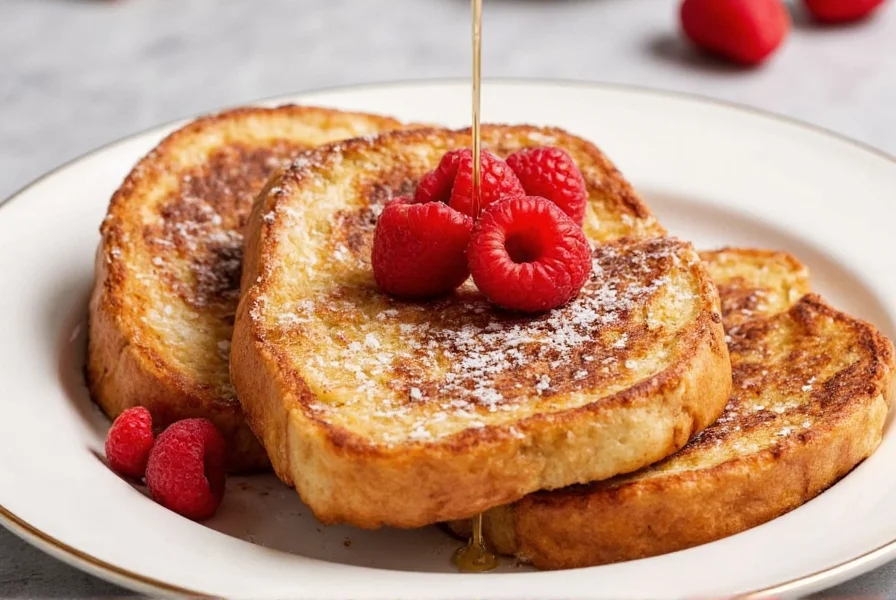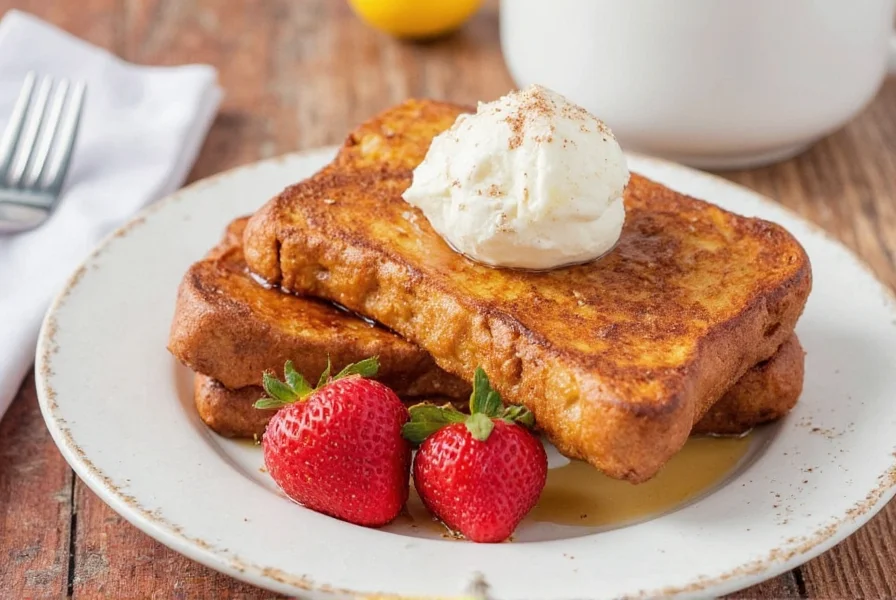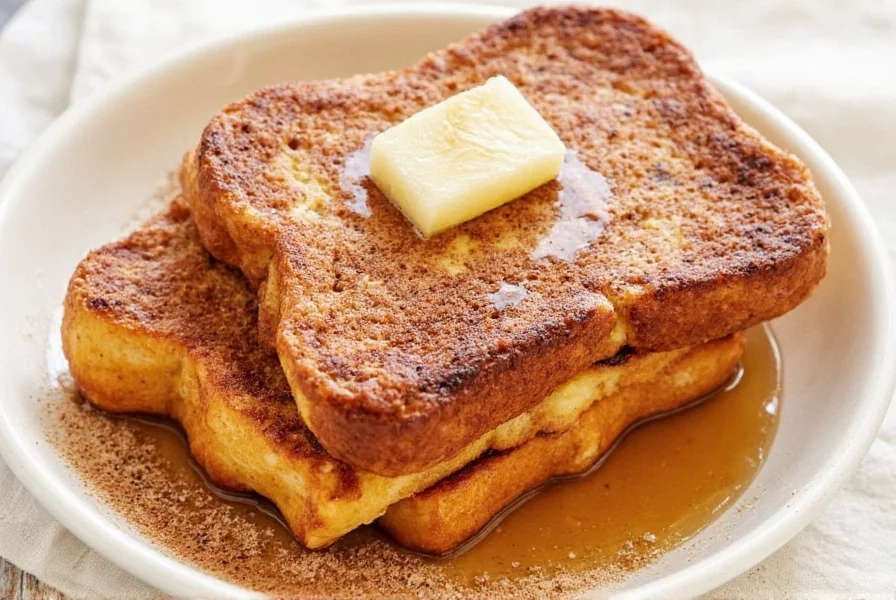If you've ever wondered how to make cinnamon french toast that rivals your favorite brunch spot, you're in the right place. This classic breakfast dish combines rich custard with warm cinnamon notes, creating a comforting meal that's surprisingly simple to prepare at home. The key to exceptional cinnamon french toast lies in the balance of ingredients, proper bread selection, and precise cooking technique.
Essential Ingredients for Perfect Cinnamon French Toast
Using quality ingredients makes all the difference in your final dish. Here's what you'll need for four servings:
| Ingredient | Amount | Why It Matters |
|---|---|---|
| Day-old bread | 8 slices (1-inch thick) | Absorbs custard without falling apart |
| Large eggs | 2 | Creates the custard base |
| Milk or half-and-half | 1 cup | Adds richness and moisture |
| Ground cinnamon | 1 teaspoon | Provides signature warm flavor |
| Vanilla extract | 1/2 teaspoon | Enhances overall flavor profile |
| Salt | Pinch | Balances sweetness |
| Butter or oil | 1-2 tablespoons | For cooking; prevents sticking |
Choosing the Right Bread for Cinnamon French Toast
The foundation of great french toast is selecting appropriate bread. While many varieties work, some perform better than others:
- Challah - The traditional choice with its rich egg content and sturdy structure
- Brioche - Adds extra richness but can become too soft if over-soaked
- Sourdough - Provides a nice tang that balances the sweetness
- French bread - A classic option with good structure
- Whole grain - For a healthier twist, though it absorbs more custard
Regardless of your choice, aim for slices that are 3/4 to 1 inch thick. Stale or day-old bread works best as it absorbs the custard mixture without disintegrating. If using fresh bread, lightly toast the slices first to remove excess moisture.

Step-by-Step Preparation Guide
Follow these detailed instructions for restaurant-quality cinnamon french toast every time:
- Prepare your bread - Cut 8 slices from your loaf, each about 1 inch thick. If bread is fresh, let slices sit uncovered for 30 minutes or toast lightly.
- Mix the custard - In a shallow dish wide enough to accommodate your bread slices, whisk together 2 eggs, 1 cup milk, 1 teaspoon cinnamon, 1/2 teaspoon vanilla, and a pinch of salt until fully combined.
- Preheat your cooking surface - Heat a griddle, cast iron skillet, or non-stick pan over medium heat (approximately 350°F/175°C). Add 1 tablespoon butter or oil.
- Dip the bread - Working with one slice at a time, dip bread into custard mixture for 20-30 seconds per side. Don't oversoak - the bread should be moistened but still hold its shape.
- Cook to perfection - Place dipped bread on the preheated surface. Cook for 3-4 minutes per side until golden brown. Adjust heat as needed to prevent burning.
- Keep warm - Transfer cooked slices to a wire rack placed over a baking sheet in a 200°F (95°C) oven while preparing remaining slices.
- Serve immediately - Top with maple syrup, powdered sugar, fresh berries, or whipped cream.
Professional Tips for the Best Results
Elevate your cinnamon french toast from good to exceptional with these expert techniques:
- Temperature control - Maintain consistent medium heat. Too hot causes burning before the center cooks; too low makes the toast soggy.
- Custard ratio matters - The ideal egg-to-milk ratio is 1 egg per 1/2 cup of milk. Too many eggs creates an omelet-like texture.
- Don't skip the salt - A pinch enhances all the flavors without making the dish taste salty.
- Rest before serving - Let cooked slices sit for 1-2 minutes to allow the custard to set slightly.
- Fresh cinnamon - Use recently purchased cinnamon for the most vibrant flavor; old spices lose potency.
Common Mistakes to Avoid
Steer clear of these frequent errors that can ruin your cinnamon french toast:
- Using thin bread slices - They become saturated too quickly and fall apart
- Over-soaking the bread - Leads to mushy texture rather than custardy interior
- Cooking at too high heat - Results in burnt exterior with raw center
- Using only cinnamon sugar - Adding cinnamon to the custard creates more balanced flavor than just sprinkling on top
- Serving immediately after cooking - Let it rest briefly for optimal texture
Variations and Customizations
Once you've mastered the classic version, try these delicious variations:
- Stuffed french toast - Spread cream cheese between two slices before dipping
- Apple cinnamon - Add 1/4 cup finely diced apples to the custard mixture
- Spiced version - Add 1/4 teaspoon nutmeg and 1/8 teaspoon cloves to the custard
- Dairy-free option - Substitute milk with coconut milk or almond milk
- Gluten-free adaptation - Use your favorite gluten-free bread (may require less soaking time)
Serving Suggestions and Pairings
Cinnamon french toast shines when paired thoughtfully with complementary elements:
- Syrups - Pure maple syrup is classic, but try bourbon maple or cinnamon-infused syrups
- Fresh fruit - Berries, sliced bananas, or caramelized apples add brightness
- Cream elements - Whipped cream, yogurt, or mascarpone provide contrast to the richness
- Crunchy toppings - Chopped nuts or granola add textural interest
- Beverage pairings - Coffee, orange juice, or a light mimosa complete the meal
Storage and Reheating Instructions
If you have leftovers (which is rare!), follow these guidelines:
- Refrigeration - Store cooled french toast in an airtight container for up to 2 days
- Freezing - Place cooled slices in a single layer on a baking sheet, freeze, then transfer to freezer bags for up to 1 month
- Reheating - For best results, reheat in a 350°F (175°C) oven for 5-8 minutes or in a toaster oven until warmed through
- Avoid microwaving - This makes the toast soggy rather than restoring crisp edges

Frequently Asked Questions
Can I make cinnamon french toast ahead of time?
Yes, you can prepare the custard mixture the night before and store it covered in the refrigerator. Dip the bread just before cooking for best results. Fully assembled french toast doesn't hold well as the bread continues to absorb the custard, becoming soggy.
Why does my french toast fall apart when cooking?
This typically happens when the bread is too fresh or has been soaked too long in the custard. Use day-old bread and limit soaking time to 20-30 seconds per side. Thicker bread varieties like challah or brioche hold together better than softer breads.
What's the ideal cooking temperature for cinnamon french toast?
Medium heat (approximately 350°F or 175°C) is ideal. The surface should sizzle gently when the bread hits the pan. If it browns too quickly, lower the heat; if it takes more than 5 minutes per side to brown, increase the heat slightly.
Can I use cinnamon sticks instead of ground cinnamon?
While you can infuse the milk with a cinnamon stick by heating it gently, ground cinnamon provides more consistent flavor distribution in the custard. For best results with cinnamon sticks, simmer 1 stick in the milk for 10 minutes, then remove before adding to the egg mixture.
How do I prevent my cinnamon french toast from becoming soggy?
Use bread that's slightly stale, don't oversoak the slices (20-30 seconds per side), and maintain proper cooking temperature. After cooking, place slices on a wire rack rather than a plate to prevent steam from making the bottom soggy. Serve immediately for best texture.











 浙公网安备
33010002000092号
浙公网安备
33010002000092号 浙B2-20120091-4
浙B2-20120091-4